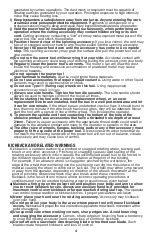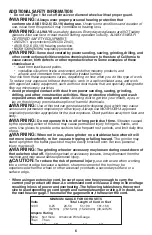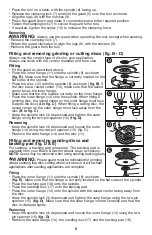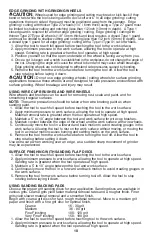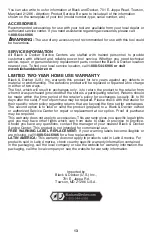
8
• Place the tool on a table, with the spindle (6) facing up.
• Release the clamping lock (7) and hold the guard (5) over the tool as shown.
• Align the lugs (8) with the notches (9).
• Press the guard down and rotate it counterclockwise to the required position.
• Fasten the clamping lock (7) to secure the guard to the tool.
• If required, tighten the screw (10) to increase the clamping force.
Removing
WARNINg
: Always use the guard when operating the tool, except when sanding.
• Release the clamping lock (7).
• Rotate the guard clockwise to align the lugs (8) with the notches (9).
• Remove the guard from the tool.
fitting and removing grinding or cutting discs (fig. B - D)
Always use the correct type of disc for your application.
Always use discs with the correct diameter and bore size.
fitting
• Fit the guard as described above.
• Place the inner flange (11) onto the spindle (6) as shown
(fig. B). Make sure that the flange is correctly located on the
flat sides of the spindle.
• Place the disc (12) onto the spindle (6) as shown (fig. B). If
the disc has a raised center (13), make sure that the raised
center faces the inner flange.
• Make sure that the disc locates correctly on the inner flange.
• Place the outer flange (14) onto the spindle. When fitting a
grinding disc, the raised center on the outer flange must face
towards the disc (A in fig. C). When fitting a cutting disc, the
raised center on the outer flange must face away from the
disc (B in fig. C).
• Keep the spindle lock (4) depressed and tighten the outer
flange using the two-pin spanner (15) (fig. D).
Removing
• Keep the spindle lock (4) depressed and loosen the outer
flange (14) using the two-pin spanner (15) (fig. D).
• Remove the outer flange (14) and the disc (11).
fitting and removing sanding discs and
backing pad (fig. D & e)
For sanding, a backing pad is required. The backing pad is
available from your Black & Decker dealer as an accessory.
NOTe: Guard may be removed when using sanding backing pads.
WARNINg
: Proper guard must be reinstalled for grinding
wheel, sanding flap disc, cutting wheel, wire brush or wire wheel
applications after sanding applications are complete.
fitting
• Place the inner flange (11) onto the spindle (6) as shown
(fig. e). Make sure that the flange is correctly located on the flat sides of the spindle.
• Place the backing pad (16) onto the spindle.
• Place the sanding disc (17) onto the backing pad.
• Place the outer flange (14) onto the spindle with the raised center facing away from
the disc.
• Keep the spindle lock (3) depressed and tighten the outer flange using the two-pin
spanner (15) (fig. D). Make sure that the outer flange is fitted correctly and that the
disc is clamped tightly.
Removing
• Keep the spindle lock (4) depressed and loosen the outer flange (14) using the two-
pin spanner (15) (fig. D).
• Remove the outer flange (14), the sanding disc (17) and the backing pad (16).
B
C
E
D




